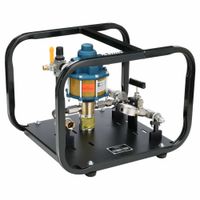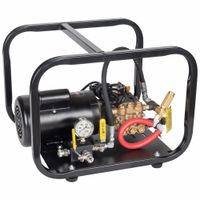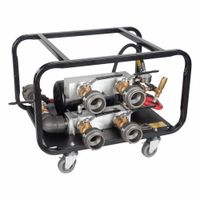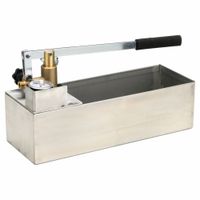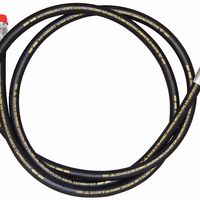Call +(254) 703 030 000 / 751 483 999 / 721 704 777
.....Read More
Frequently Asked Questions
What is a hydrostatic test pump used for?
A hydrostatic test pump is used to test the integrity and strength of pressure vessels, pipelines, plumbing systems, and other fluid-containing structures. It is a crucial tool in industries such as construction, manufacturing, and maintenance, ensuring that these systems can withstand their intended operating pressures without leaking or failing.
The process involves filling the vessel or pipeline with a liquid, usually water, and then pressurizing it to a level higher than its normal operating pressure. This is done to identify any leaks, weaknesses, or defects in the system. The test helps in verifying the durability and safety of the structure, ensuring compliance with safety standards and regulations.
Hydrostatic test pumps come in various types, including manual, electric, and gas-powered models, each suited for different applications and pressure requirements. Manual pumps are typically used for smaller systems or where portability is essential, while electric and gas-powered pumps are used for larger systems requiring higher pressures.
The test is conducted by connecting the pump to the system, filling it with the test liquid, and gradually increasing the pressure while monitoring for any drops in pressure or visible leaks. If the system maintains the pressure without any loss, it is considered to have passed the test. If not, repairs are made, and the test is repeated until the system is deemed safe.
Overall, hydrostatic test pumps are essential for ensuring the safety, reliability, and longevity of pressure systems, preventing potential failures that could lead to costly repairs, environmental damage, or safety hazards.
How does a hydrostatic test pump work?
A hydrostatic test pump is used to test the integrity and strength of pipes, plumbing systems, and pressure vessels by filling them with a liquid, usually water, and pressurizing the system to a specified level. The process begins by connecting the pump to the system being tested. The pump draws water from a reservoir or directly from a water source and forces it into the system.
The pump typically consists of a motor or manual handle, a pressure gauge, a water inlet, and an outlet connected to the system. When the pump is activated, it increases the pressure of the water, which is then pushed into the system. The pressure gauge allows the operator to monitor the pressure level, ensuring it reaches the required test pressure without exceeding the system's limits.
Once the desired pressure is achieved, the system is observed for a set period to check for leaks or pressure drops, which would indicate a failure in the system's integrity. If the pressure remains stable, the system is considered sound. If not, the location of the leak must be identified and repaired before retesting.
Hydrostatic test pumps can be manual, electric, or gas-powered, with manual pumps being suitable for smaller systems and electric or gas-powered pumps used for larger, more complex systems. The choice of pump depends on the size of the system, the required pressure, and the testing environment.
What are the different types of hydrostatic test pumps?
Hydrostatic test pumps are used to test the integrity and strength of pipes, pressure vessels, and other fluid systems by pressurizing them with water. The different types of hydrostatic test pumps include:
1. **Hand Pumps**: These are manually operated and suitable for small-scale applications or where portability is essential. They are ideal for low-pressure testing and are often used in remote locations without power access.
2. **Electric Pumps**: Powered by electricity, these pumps are used for medium to high-pressure testing. They are efficient and suitable for repetitive testing tasks, offering consistent pressure and flow rates. They are commonly used in industrial settings.
3. **Gas-Powered Pumps**: These pumps use gasoline or diesel engines, making them suitable for high-pressure applications and locations without electrical power. They are robust and can handle large volumes, often used in construction and pipeline industries.
4. **Pneumatic Pumps**: Operated using compressed air, pneumatic pumps are ideal for environments where electricity or fuel is not feasible. They are safe for use in hazardous areas due to the absence of electrical components.
5. **Hydraulic Pumps**: These pumps use hydraulic fluid to generate pressure and are suitable for very high-pressure applications. They are often used in heavy industrial settings where precise pressure control is required.
6. **Diaphragm Pumps**: Utilizing a diaphragm mechanism, these pumps are suitable for handling corrosive or abrasive fluids. They are often used in chemical industries for testing systems that require special fluid handling.
Each type of pump is selected based on the specific requirements of the testing application, including pressure range, fluid compatibility, and environmental conditions.
How do you perform a hydrostatic test?
To perform a hydrostatic test, follow these steps:
1. **Preparation**:
- Ensure the test object (e.g., pipeline, tank) is isolated and emptied of any contents.
- Inspect for any visible damage or defects.
- Clean the interior to remove debris or contaminants.
2. **Filling**:
- Fill the test object with water or another incompressible fluid. Ensure the fluid is free of air bubbles, as air can compress and affect test accuracy.
- Use a pump to fill the object slowly, allowing air to escape through vents.
3. **Pressurization**:
- Gradually increase the pressure using a pump until the desired test pressure is reached. This pressure is typically higher than the normal operating pressure.
- Monitor the pressure gauge to ensure it reaches the specified level.
4. **Holding**:
- Maintain the test pressure for a specified duration, usually determined by standards or regulations.
- Inspect for leaks, deformations, or any signs of failure. This can be done visually or using sensors.
5. **Inspection**:
- Check all joints, welds, and connections for leaks. Use visual inspection or leak detection solutions.
- Record any pressure drops, which may indicate a leak.
6. **Depressurization**:
- Slowly release the pressure to avoid sudden changes that could damage the object.
- Drain the test fluid safely, ensuring environmental regulations are followed.
7. **Documentation**:
- Record the test results, including pressure levels, duration, and any observations.
- Prepare a report detailing the test procedure and outcomes.
8. **Post-Test**:
- Inspect the test object for any residual damage.
- Restore the object to its operational state if it passes the test.
Ensure compliance with relevant safety standards and regulations throughout the process.
What is the difference between electric, air, and gas-operated hydrostatic test pumps?
Electric, air, and gas-operated hydrostatic test pumps differ primarily in their power sources and applications:
1. **Electric Hydrostatic Test Pumps**:
- **Power Source**: Operated using electricity, typically requiring a connection to an electrical outlet or generator.
- **Applications**: Ideal for indoor use or environments where electricity is readily available. Commonly used in industrial settings, construction sites, and maintenance facilities.
- **Advantages**: Generally quieter and more efficient, with consistent power output. They offer precise control over pressure and flow rates.
- **Limitations**: Limited by the availability of electrical power and may not be suitable for remote locations without access to electricity.
2. **Air-Operated Hydrostatic Test Pumps**:
- **Power Source**: Powered by compressed air, requiring an air compressor to function.
- **Applications**: Suitable for environments where electricity poses a risk, such as explosive atmospheres or wet conditions. Often used in petrochemical, oil, and gas industries.
- **Advantages**: Safe for use in hazardous areas due to the absence of electrical components. Portable and easy to set up.
- **Limitations**: Dependent on the availability of a reliable air supply. May have lower pressure capabilities compared to electric pumps.
3. **Gas-Operated Hydrostatic Test Pumps**:
- **Power Source**: Utilize gasoline or diesel engines for operation.
- **Applications**: Best suited for remote or outdoor locations where electricity and compressed air are unavailable. Common in pipeline testing and fieldwork.
- **Advantages**: Highly portable and independent of external power sources. Capable of high-pressure outputs.
- **Limitations**: Produce emissions and noise, which may not be suitable for all environments. Require regular maintenance and fuel supply.
Each type of pump is chosen based on the specific requirements of the testing environment, availability of power sources, and safety considerations.
What safety precautions should be taken when using a hydrostatic test pump?
When using a hydrostatic test pump, several safety precautions are essential to ensure safe operation and prevent accidents:
1. **Personal Protective Equipment (PPE):** Always wear appropriate PPE, including safety goggles, gloves, and steel-toed boots, to protect against high-pressure fluid leaks and accidental contact with equipment.
2. **Training and Familiarization:** Ensure that all operators are adequately trained and familiar with the pump's operation, including emergency shutdown procedures.
3. **Equipment Inspection:** Before use, inspect the pump and all associated equipment for any signs of damage, wear, or leaks. Ensure all connections are secure and that hoses are in good condition.
4. **Pressure Rating Compliance:** Verify that the test pump and all components, including hoses and fittings, are rated for the pressure to be applied during the test.
5. **Area Safety:** Clear the testing area of unnecessary personnel and equipment. Establish a safe perimeter to prevent unauthorized access during testing.
6. **Pressure Relief Valve:** Ensure a properly functioning pressure relief valve is installed to prevent over-pressurization, which could lead to equipment failure or injury.
7. **Gradual Pressure Increase:** Increase pressure gradually to avoid sudden surges that could cause equipment failure or leaks.
8. **Monitoring:** Continuously monitor pressure gauges and equipment for any signs of malfunction or leaks during the test.
9. **Emergency Procedures:** Have clear emergency procedures in place, including how to quickly depressurize the system if necessary.
10. **Documentation:** Keep detailed records of the test, including pressure levels, duration, and any anomalies observed, for future reference and compliance.
11. **Post-Test Inspection:** After testing, depressurize the system safely and inspect all equipment for any damage or wear before storage or further use.
How do you maintain a hydrostatic test pump?
To maintain a hydrostatic test pump, follow these steps:
1. **Regular Inspection**: Frequently inspect the pump for any signs of wear, damage, or leaks. Check hoses, connections, and seals for integrity.
2. **Fluid Levels**: Ensure the hydraulic fluid is at the correct level. Use the manufacturer-recommended fluid and replace it periodically to prevent contamination.
3. **Filter Maintenance**: Clean or replace filters regularly to ensure the pump operates efficiently and to prevent debris from entering the system.
4. **Lubrication**: Lubricate moving parts as per the manufacturer's guidelines to reduce friction and wear.
5. **Pressure Gauge Calibration**: Regularly calibrate the pressure gauge to ensure accurate readings. Replace it if it shows signs of malfunction.
6. **Valve Check**: Inspect and test all valves for proper operation. Clean or replace them if they are not functioning correctly.
7. **Hose Care**: Store hoses properly to prevent kinks and damage. Inspect them for cracks or wear and replace them as needed.
8. **Pump Cleaning**: Clean the pump after each use to remove any residue or debris that could cause damage or inefficiency.
9. **Storage**: Store the pump in a clean, dry place to prevent rust and corrosion. Cover it to protect it from dust and environmental elements.
10. **Operational Testing**: Periodically run the pump to ensure it is functioning correctly. Listen for unusual noises that could indicate a problem.
11. **Documentation**: Keep a maintenance log to track inspections, repairs, and replacements. This helps in identifying recurring issues and planning preventive maintenance.
12. **Professional Servicing**: Schedule regular professional servicing to address complex issues and ensure the pump remains in optimal condition.
What are the NFPA standards for fire hose testing?
The National Fire Protection Association (NFPA) sets standards for fire hose testing primarily in NFPA 1962, "Standard for the Care, Use, Inspection, Service Testing, and Replacement of Fire Hose, Couplings, Nozzles, and Fire Hose Appliances." Key points include:
1. **Inspection and Testing Frequency**: Fire hoses should be inspected and service-tested at least annually. After being repaired or recoupled, hoses must also undergo testing before being placed back in service.
2. **Visual Inspection**: Hoses should be visually inspected for damage, wear, or deterioration. This includes checking for mildew, rot, cuts, abrasions, and damage to couplings.
3. **Service Testing**: Hoses must be tested at a pressure not less than the service test pressure marked on the hose. If not marked, the test pressure should be 300 psi for attack hoses and 200 psi for supply hoses.
4. **Testing Procedure**: The hose should be laid out straight, filled with water, and pressurized gradually. The pressure should be maintained for a minimum of three minutes. Observers should stand at a safe distance during testing.
5. **Documentation**: Results of the hose testing, including any failures, should be documented. Records should include the date, test pressure, duration, and any defects found.
6. **Failure and Replacement**: Hoses that fail the test should be removed from service. Hoses showing signs of damage or wear that could lead to failure should also be replaced.
7. **Couplings and Nozzles**: These should be inspected for damage, corrosion, and proper operation. Any defective components should be repaired or replaced.
These standards ensure that fire hoses are reliable and safe for use in firefighting operations.
How do you identify leaks using a hydrostatic test pump?
To identify leaks using a hydrostatic test pump, follow these steps:
1. **Preparation**: Ensure the system to be tested is isolated and drained. Close all valves and remove air from the system to prevent false readings.
2. **Filling**: Connect the hydrostatic test pump to the system. Fill the system with water, ensuring it is completely filled to avoid air pockets, which can affect pressure readings.
3. **Pressurization**: Gradually increase the pressure using the pump to the specified test pressure, which is usually higher than the normal operating pressure. Monitor the pressure gauge closely.
4. **Stabilization**: Once the desired pressure is reached, stop the pump and allow the system to stabilize. This may take a few minutes as the water temperature and pressure equalize.
5. **Monitoring**: Observe the pressure gauge for a set period, typically 15-30 minutes. A drop in pressure indicates a potential leak.
6. **Inspection**: Visually inspect the system for any signs of water leakage. Pay close attention to joints, connections, and welds, as these are common leak points.
7. **Detection**: If a pressure drop is observed but no visible leaks are found, use leak detection methods such as applying soapy water to suspect areas and looking for bubbles, or using electronic leak detection equipment.
8. **Documentation**: Record the initial and final pressure readings, test duration, and any observations. This documentation is crucial for verifying the integrity of the system and for future reference.
9. **Repair and Retest**: If leaks are identified, repair them and repeat the test to ensure the system is leak-free.
By following these steps, leaks can be effectively identified and addressed using a hydrostatic test pump.
What are the benefits of using a hand-operated hydrostatic test pump?
A hand-operated hydrostatic test pump offers several benefits, particularly in scenarios where portability, simplicity, and cost-effectiveness are crucial.
1. **Portability**: These pumps are lightweight and compact, making them easy to transport and use in various locations, including remote or hard-to-reach areas where power sources may not be available.
2. **Cost-Effectiveness**: Hand-operated pumps are generally less expensive than their electric or motorized counterparts, both in terms of initial purchase and maintenance costs. They do not require electricity or fuel, reducing operational expenses.
3. **Simplicity and Reliability**: With fewer moving parts and no reliance on external power, these pumps are less prone to mechanical failure. Their straightforward design makes them easy to operate and maintain, even for users with minimal technical expertise.
4. **Precision and Control**: Users can manually control the pressure applied during testing, allowing for precise adjustments and ensuring that the pressure is increased gradually. This reduces the risk of over-pressurization and potential damage to the system being tested.
5. **Versatility**: Hand-operated hydrostatic test pumps can be used for a variety of applications, including testing pipelines, pressure vessels, plumbing systems, and sprinkler systems. They are suitable for both low and high-pressure testing, depending on the model.
6. **Environmentally Friendly**: Since they do not require electricity or fuel, these pumps have a minimal environmental impact, making them an eco-friendly choice for pressure testing.
7. **Safety**: The manual operation allows for immediate cessation of pressure application if a problem is detected, enhancing safety during testing procedures.
Overall, hand-operated hydrostatic test pumps are an excellent choice for those seeking a reliable, cost-effective, and versatile solution for pressure testing in various environments.
